Why Product-Led Growth Needs Scalable Product Engineering Services
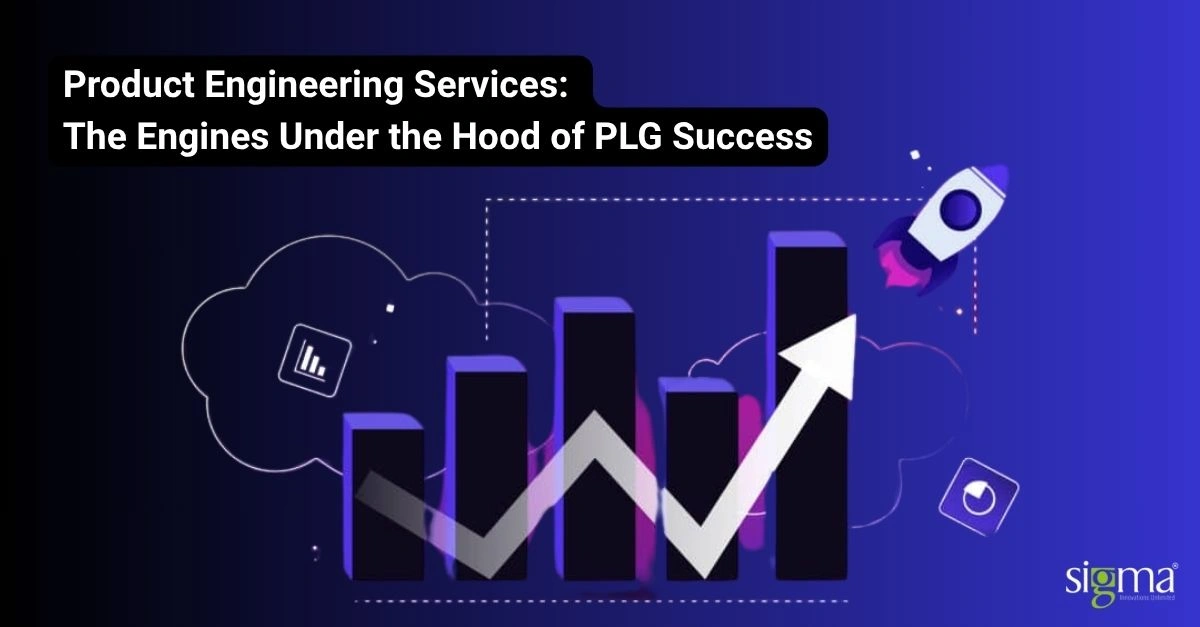
Hailed as a panacea for tech companies, enterprises are betting high on PLG—product-led growth. The strategy is often considered the “holy grail” for achieving efficient growth and above-average returns. A product-led growth model is like a top-tier vehicle—designed for speed and efficiency, but it needs a strong engine to hit the road—the product engineering services. PLG has emerged as the leading growth strategy for today’s digital-first companies. But while front-end UX often gets the spotlight, it’s the product engineering that keeps everything running at scale.
Unleashing an Enterprise’s Superpowers: Product-led Growth and the Art of Unified Impact
Each superhero has a different power, a different style, and a different agenda. On their own, they are powerful, but when uncoordinated, they can work at cross purposes. Product-led growth is like forming the Avengers! Now, consider each team in an enterprise as a superhero. PLG breaks silos, unites them, and makes them work in unison around a single mission: the user’s journey. As each team brings its own superpower or unique value to the table, the result isn’t just collaboration—it’s orchestration. As a powerful, cohesive force where the product becomes the hero leading the charge, product led growth framework creates a league where everyone plays to their strengths, ultimately helping the end user win.
What is Product-led growth?
Product-led growth (PLG) focuses on using the product itself to drive customer acquisition, engagement, and retention.
What is Product Engineering in the context of product-led growth?
Concerning product-led growth (PLG), product engineering transcends just building functional software. It shifts focus to creating scalable, intuitive, and continuously evolving products that drive user adoption and business growth via the product.
The Mainstays of PLG-focused Product Engineering
Product engineering serves as a foundation transform PLG into business impact. Going above and beyond the support function, product engineering is a strategic engine fostering user-centric innovation and scalability for retail businesses, fintech companies, and several other enterprises across industries. Here is a breakdown of the product engineering essentials that enable PLG success.:
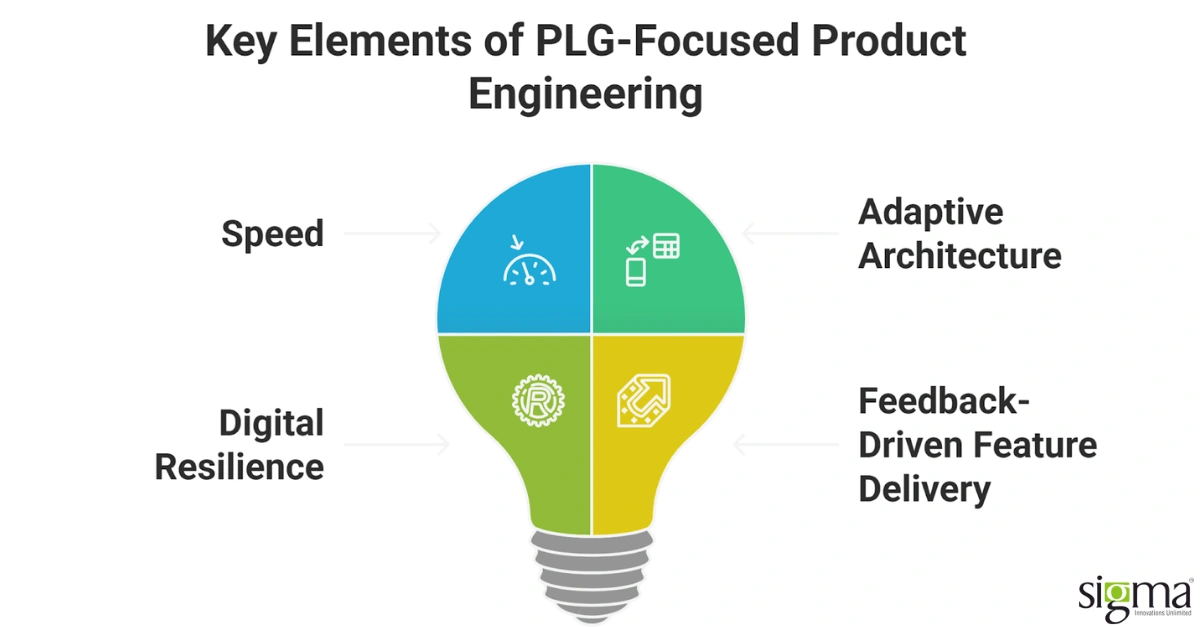
1. Speed is everything
Enterprises must meet ever-evolving user expectations in real time. Hence, any scope of late deliveries or slow iteration cycles diminishes. Agile methodologies, continuous integration/continuous deployment, and real-time feedback loops come into the picture. Product development cycles are shortened, owing to agile sprints, helping businesses respond quickly to user needs. Besides this, software development techniques that enable or disable features at runtime without deploying new code pave the way for A/B testing, creating an ambient environment for safe experimentation. Owing to this, businesses can let data and not assumptions or gut feelings guide their product decisions. Software product engineering services enable fast iteration cycles, helping product development teams to ship, test, and learn quickly and rapidly align products as per the user’s needs.
2. Adaptive Architecture
A company looking to cash in on product-led growth must be well-prepared and equipped to handle usage spikes. In the context of product-led growth, product engineering services empower businesses to go beyond just handling traffic spikes and prepare them for success. With usage spikes becoming the norm, the backend needs to be scaled. Microservices allow individual components to scale independently and be deployed faster. Serverless infrastructure decreases overhead, creating ample scope for flexible scaling as per the demand and cloud-native platforms’ elastic infrastructure without sacrificing performance.
3. Digital Resilience
For companies striving for product-led growth, uptime is not a performance metric but a promise. As the product is always on stage, the company’s growth stalls when it is slow or unreliable, negatively impacting the trust factor or the enterprise’s goodwill. Implementing high-availability architectures with auto-recovery and fault tolerance, leveraging observability stacks for proactive incident response, and applying infrastructure as code (IaC) for consistency and rapid recovery are all a part of product engineering services that foster digital resilience vital for PLG.
Read the blog to learn more about achieving digital resilience through product engineering services
4. Feedback-Driven Feature Delivery
For an enterprise, feedback data fuels product-led growth strategy because good data drives product evolution at the code level. All the same, in several scenarios, users don’t say out loud but give out subtle signals through behaviour. Product engineering is at the forefront of making this data visible and actionable. With embedded analytics, businesses can create event tracking pipelines to keep an eye on bottlenecks and feature adoption and use this data for sprint planning endeavors, and priorotiziing feature releases. Good data isn’t just collected—it drives product evolution at the code level.
PLG is more than just a go-to-market strategy—it’s a product engineering mindset. Fast iterations, scalable infrastructure, resilient uptime, and data feedback loops aren’t optional—they’re the core infrastructure of product-led success bestowed by the best product engineering services.
Did you know?
91% of companies plan to increase their product-led growth investment
Product-led growth companies are growing 50% year over year
Source: Productled.com Openview
How Efficient Product Engineering Become the Corner-Stone of PLG!
From code to conversion, The secret sauce behind PLG: Product engineering! Here is an overview of engineering strategies for PLG success.
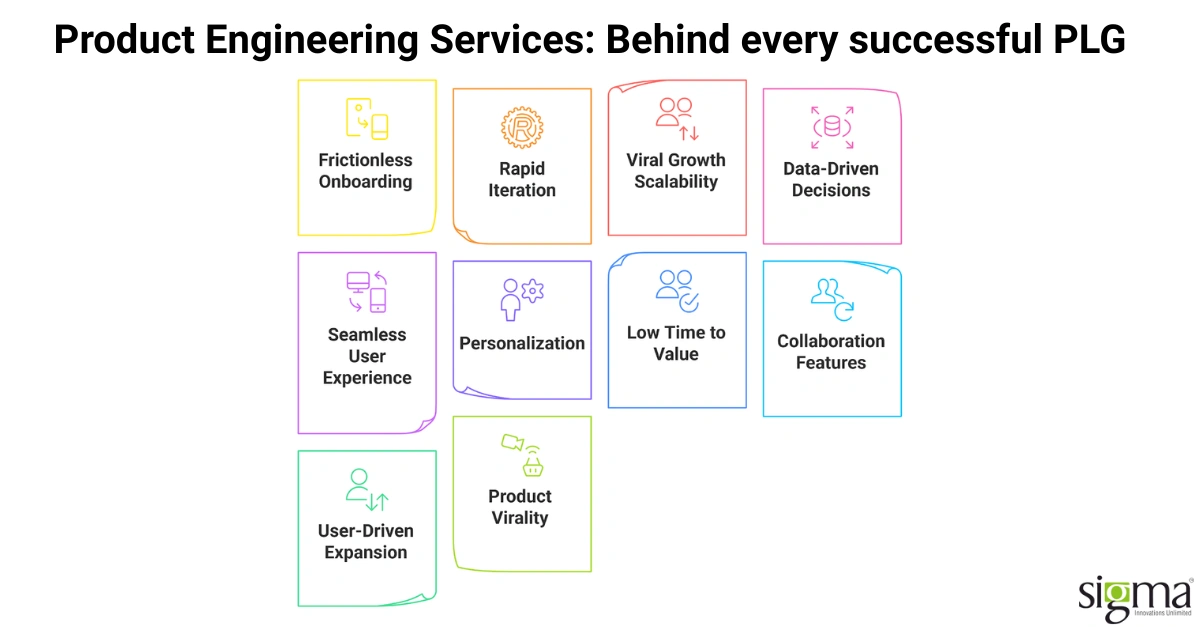
1. Enabling frictionless onboarding:
Intuitive UX design, self-serve architecture, and automated setup flow make it easy for users to get started without assistance.
2. Rapid iteration and experimentation:
Implementing CI/CD pipelines, feature flag systems, and A/B testing frameworks to test and deploy changes quickly and safely.
3. Supporting scalability:
Cloud-native architecture, microservices, and elastic infrastructure ensure product scalability as the user demand increases.
4. Enabling data-driven product decisions:
Embedding analytics, tracking user behavior, and events triggered, allows businesses to understand user interaction with the product and iterate accordingly.
5. A seamless user experience:
Creating a smooth and consistent experience for all users via performance optimization, cross-platform compatibility, and responsive design.
6. Enabling personalization and user segmentation:
Supporting dynamic and personalized user journeys through modular backends, real-time data pipelines, and rules-based content delivery systems
7. Reducing Time to Value (TTV) for new users:
Allowing users to realize product value quickly and efficiently through API integrations and guided walkthroughs
8. Supporting built-in collaboration features:
Real-time sync engines, permission control systems, and shared workspace functionality enable users to collaborate effectively within the product.
9. Technically supporting user-driven expansion
Fostering natural growth within teams and organizations through usage-based billing systems, role-based access controls, and in-product upgrade paths.
10. Supporting product virality
Encouraging users to invite others and increase product usage by creating referral systems and support for deep linking.
Product engineering snags that undermine PLG
Leveraging digital product engineering services is the go-to solution for businesses vying for a revenue upsurge via PLG. However, several aspects of product engineering come into play, impacting PLG. Though PLG thrives on speed, agility, and seamless user experiences, hidden blockers like tech debt, manual QA, rigid monoliths, and siloed teams can bring it to a halt. Here is an overview of pitfalls businesses building products for product-led growth should watch out for while leveraging product engineering.
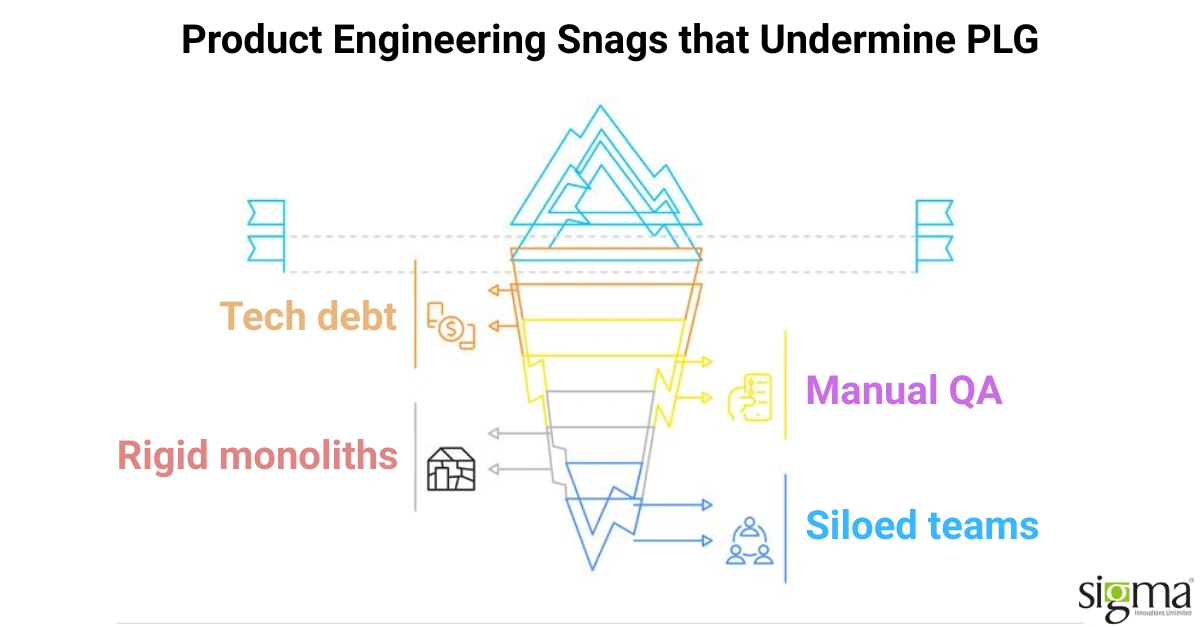
1. Tech debt stalling speed
Through shortcuts in software development, businesses can fast-track a full cycle product development and sidestep the consequences of technical debt. They may not suffer immediate consequences of technical debt, but it significantly slows down a project in the long run, creating obstacles for product-led growth.
Technical debt makes it difficult for developers to ship high-quality code quickly, increasing the risk of errors and rework. It increases build times, forcing developers to context-switch, negatively impacting productivity and the system’s performance. Technical debt also increases the risk of introducing bugs into the systems, inhibiting the addition of new features, and sabotaging the innovative ability of an organization. To put an end to technical debt, collaborate with a product engineering service provider and innovate better and faster.
Read the blog to know why tackling technical debt is imperative for a competitive edge.
2. Manual QA slowing down releases
In a product-led growth (PLG) context, manual Quality Assurance (QA) slows down product releases, especially when it concerns a large number of features and iterations. Manual testing can be error-prone and may miss certain edge cases, limiting the frequency of product releases and increasing production costs for the business. Additionally, if manual testing reveals critical bugs or usability issues late in the process, it leads to significant delays in release timelines. A fix to this is implementing automated testing and a “shift left” approach, where QA is undertaken in the initial development lifecycle. Also, leveraging continuous integration and continuous delivery (CI/CD) ensures frequent releases, and the use of high-quality code reduces the need for constant manual testing or QA.
3. Rigid monoliths limit experimentation
Rigid, legacy systems built on monolithic architecture hinder experimentation in PLG, leading to slow deployment cycles and increasing the risk of cascading failures. Owing to these limitations, businesses fail to quickly test hypotheses and iterate on new features or product enhancements. It creates a void, preventing businesses from accessing feedback and data-driven insights that are paramount for PLG. As in monolithic applications, changes are hard to isolate, creating roadblocks for PLG-driven businesses to evaluate the impact of individual features or experiments.
While using monolithic systems, companies face a massive risk of cascading failure because glitches or foundering errors result in widespread outages, completely ruining the user experience. Rigid monoliths make testing of product features for a specific user segment cumbersome, thwarting an enterprise’s customization and user engagement efforts. This creates a massive lacuna for a business working towards offering personalized user experiences for ramping up customer acquisition. Additionally, monolithic architectures restrict rapid experimentation as they are less adaptable and scalable. To overcome the challenges associated with monolithic architecture, businesses must switch to microservices architecture for product-led growth.
4. Siloed engineering teams disconnected from product goals
When the engineering teams work in silos, PLG goals are undermined, stifling innovation and slackening the customer experience. However, the story seems different when there is cross-functional collaboration, resulting in effective PLG where all the teams in an organization work towards aligned or shared goals. When teams operate in silos, features may be developed without a clear understanding of customer needs or the overall product vision, reducing the product’s ability to drive acquisition, conversion, and retention. Innovation is also stunted, as engineering efforts may lack strategic direction or feedback loops. This disconnection often results in features that misalign with user expectations, leading to poor customer experiences and reduced adoption.
Additionally, siloed workflows delay release cycles, limiting a company’s responsiveness to market demands. Ultimately, without unified execution, PLG strategies become fragmented and ineffective, weakening their potential for organic growth and user-driven momentum. A quick fix to this is establishing clear product goals and fostering collaboration among verticals and teams of an organization by implementing a centralized product roadmap.
Blueprints to Builds: The Impact of Leveraging Product Engineering Services for PLG- Based Companies
PLG-based companies run on great product engineering services. Collaborating with a product engineering service provider allows businesses to stay focused on product vision, go-to-market strategy, and growth loops, while a trusted engineering partner handles implementation, iteration, and plugs gaps in DevOps. Effective product development services for PLG are like a technical foundation to build, scale, and continuously improve a product that drives its growth. Here are a few top-of-the-bunch reasons that make product engineering services imperative for PLG-based companies.
In-Production Examples: Product engineering fostering product-led growth
A few real-world examples of product engineering being the backbone of product-led growth.
Seamless Onboarding & Scalable Infrastructure
Cloud-based video conferencing platforms made it easy for users to sign up, and invite others to meetings frictionless. Apt product engineering made a highly scalable and reliable infrastructure supporting millions of users, fostering immense product-led growth for businesses offering virtual meeting tools.
Fast Feature Rollouts & User-Led Iteration
Companies offering graphic design tools put product engineering to ship features rapidly and iterate them based on user data. Product engineering capabilities allow them to continuously track user interaction with the product and utilize those insights to improve or add features.
Strong engineering foundations—like scalable systems, fast development cycles, and a focus on usability—directly fuel PLG.
Read our success story on BI & Analytics Solution for a Lender to build a comprehensive data warehouse.
The PLG Engine: Sigma’s Product Engineering Services
Sigma Infosolutions, one of the best product engineering services companies in the USA enables product-led companies to overcome technical hurdles. It enables PLG enterprises to rebuild the product with a modular architecture, facilitating weekly releases, and reducing churn. With containerized infrastructure, PLG and DevOps integration, and automation, Sigma’s product engineering solutions empower companies to autoscale and further increase user adoption.
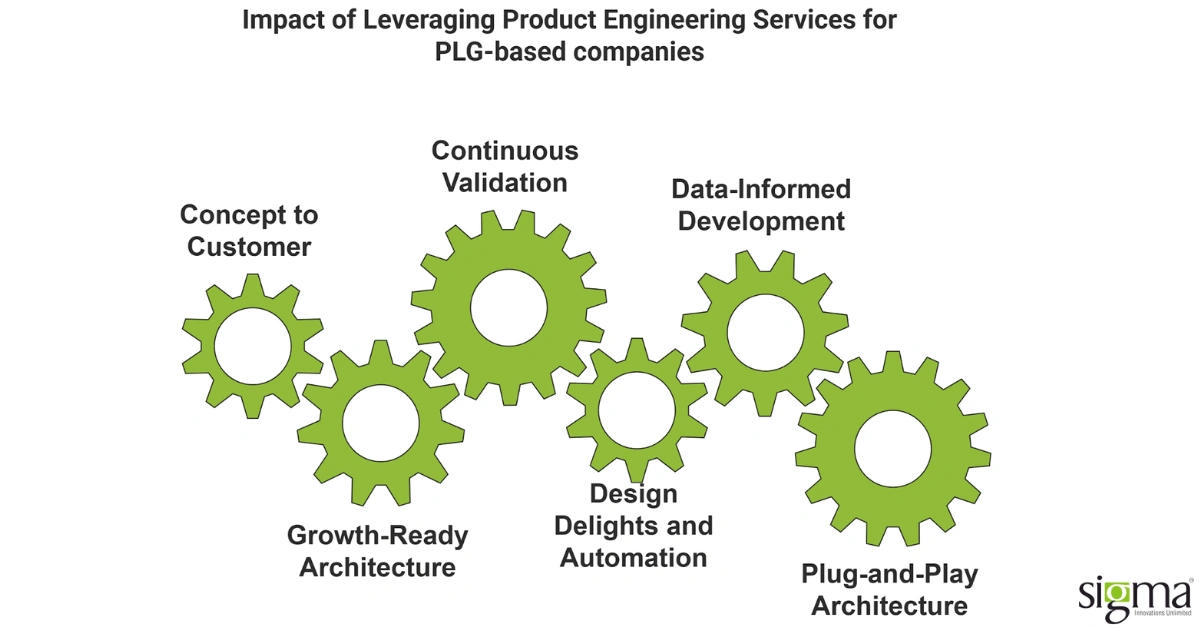
- PLG Pillar
- Self-Serve Experiences
- Viral Loops & Sharing
- Fast Iteration
- Data-Driven Decisions
- Scalability
- Engineering Need
- Smooth UX, scalable backend
- Real-time performance, secure infra
- Agile, CI/CD pipelines
- Product analytics, feedback loops
- Handle traffic spikes, multi-tenancy
- How Sigma Supports
- UX engineering, headless architecture, REST/GraphQL APIs
- Cloud-native deployments, performance tuning, CDN integration
- Agile pods, CI/CD tools, QA automation
- Integration with with various analytical tools
- AWS, Azure, Kubernetes, microservices
1. For Self-Serve Experience:
With robust product engineering capabilities, we create a perfect blend of UX engineering, with headless architecture and REST/GraphQL APIs and In-app user experience engineering, to formulate intuitive, responsive interfaces with a scalable backend.
Outcome: No additional engineering overhead for PLG companies, but they can offer scalable, frictionless digital journeys and personalized experiences to their users.
2. For Viral Loops & Sharing:
With a product engineering approach built to enable viral loops and frictionless sharing, we facilitate organic growth for product-led companies. Ensuring real-time performance, cloud-native scalability, and secure infrastructure, with deep expertise in CDN integration, performance tuning, and modern deployment practices, we deliver fast, reliable, and shareable experiences.
Outcome: PLG-based companies need not compromise on speed or security but can amplify their user reach and drive engagement.
3. For Fast Iteration:
Sigma, as a product engineering services company, accelerates product development through fast, iterative cycles tailored for product-led growth. Operating in agile pods, leveraging CI/CD pipelines, we rapidly ship features. Combined with automated QA and continuous feedback loops, this setup enables faster releases, reducing time to market.
Outcome: Companies need not have to compromise on quality and instead will have the flexibility to respond quickly to user needs.
4. For Data-Driven Decisions:
Sigma’s software product engineering services empower product-led companies to make data-driven decisions by embedding analytics directly into product development cycles. Our solutions integrate seamlessly with various analytical tools, capturing meaningful user behaviour and engagement data, fuelling continuous improvement, crucial for optimizing user journey in PLG products.
Outcome: Businesses can stop missing the mark and instead iterate smarter, prioritize features that their users want, and align their products as per real-world usage patterns.
5. For scalability:
Our product engineering services allow businesses to formulate products with scalability at the core, ensuring they can seamlessly handle traffic spikes, support multi-tenancy, and grow along with the user base. Leveraging cloud platforms, Kubernetes and microservices architecture, we enable flexible deployments and build resilient systems that can scale horizontally.
Outcomes: PLG companies need not compromise on product performance, they can manage heavy user load and sustain growth in a product-led environment.
Wrapping up:
Product-led growth thrives on speed, scale, and seamless experiences—all powered by strong product engineering. If you are a CEO, CTO, CXO of a PLG company, you can leverage Sigma Infosolutions’ product engineering services, to create products that strike the right chord with their users and steer their venture toward success.




